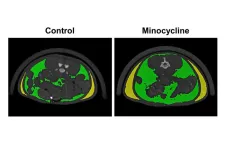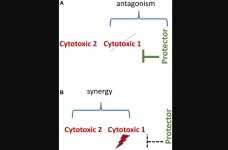Most individuals treat their acne with topical therapies; however, around 25% of adolescents require systemic antibiotics, such as minocycline, to help to alleviate symptoms and clear up the skin. These systemic antibiotic treatments often require long-term use – sometimes up to two years. Importantly, the effects of such long-term use of antibiotics during adolescence are unclear.
Researchers at the Medical University of South Carolina (MUSC) show in work published online on March 9 in The American Journal of Pathology that the makeup of the gut microbiome influences the accumulation of central (abdominal) fat, called adiposity. Disruptions in the microbiome resulting from long-term antibiotic therapy during adolescence dysregulated the expression of genes involved in lipid metabolism within the liver, causing increased accumulation of fat. Interestingly, the accumulation of fat was observed after antibiotic treatment was stopped.
“Prolonged antibiotic exposure during adolescence can have lasting detrimental effects on liver metabolism and promote adiposity,” summarized Matthew Carson, first author on this study and a graduate student studying the effects of disruption of the gut microbiome on host physiology in the Novince lab.
“I think this work raises important questions. If these observations are also happening clinically, and not just in preclinical studies, we need to reevaluate the use of these antibiotics for adolescent acne,” added Chad Novince, D.D.S., Ph.D., principal investigator and associate professor in the Department of Oral Health Sciences in the College of Dental Medicine.
Early studies looking into the effects of antibiotics during infancy, such as those given to patients with recurring ear infections, found that these therapies increased the risk of higher fat accumulation and obesity later in life. At that time, researchers thought the microbiome matured in the first few years of life; however, recent investigations have determined that the gut microbiome continues to develop into a stable state throughout adolescence.
So how does antibiotic use influence fat accumulation during adolescence?
To answer that question, Carson and Novince administered a clinically relevant dose of minocycline to mice during pubertal/postpubertal growth – the equivalent age of adolescence in humans. They found that the minocycline treatment caused a significant change in the gut microbiome. Furthermore, minocycline treatment altered liver metabolism, showing a particular dysregulation in the expression of genes involved in fatty acid and cholesterol metabolism. These changes resulted in a four-times greater increase in fatty tissue.
“Who would have thought being prescribed these antibiotics as a treatment for acne during adolescence could then lead to long-term effects on metabolism and potentially put you at risk for obesity later in life,” said Novince.
The researchers went on to show the reason behind these metabolic changes – communication between the gut and the liver was disrupted.
Normally, signaling molecules called bile acids travel from the liver to the small intestine to aid in digestion and break down fat. Microbes in the small intestine modify the bile acids and activate communication with other anatomic sites. Some of this important communication centers around regulating metabolism and adiposity.
Minocycline therapy altered the composition of the gut microbiome, which suppressed bile acid signaling pathways in the intestine. This weakened communication signals between the intestine and the liver. The liver doesn’t receive enough proper communication and turns on genes responsible for increasing adiposity.
One of the more intriguing aspects of this study was the fact that increased fat accumulation was observed after the antibiotic treatment was stopped. While the researchers are unsure why this happens, it is an interesting area for future research.
It is important to define which bacterial communities contribute to the increased fat accumulation. Of note, two bacterial genera linked to adiposity were found to be dysregulated following minocycline therapy.
“Our next step is to really pin down whether the mechanism of adiposity is dependent on minocycline-induced shifts in the microbiome,” explained Carson. “Right now, we are carrying out fecal microbiome transfer studies - transferring the microbiome from untreated and minocycline-treated mice to germ-free mice to see if the high adipose phenotype is recapitulated.”
In summary, this work strengthens the importance of the gut-liver communication network. The results of this study corroborate previous work from Carson and Novince that showed minocycline treatment impaired adolescent skeleton maturation. Together, these studies show that long-term antibiotic use during adolescence has detrimental effects on physiologic growth and maturation.
“We’ve been able to link sustained disruptions in the gut microbiome to disruptions in the gut-liver communication axis that has effects on metabolism, adiposity, the skeleton and potentially many other systems,” said Novince. “It highlights the need to be aware of antibiotic effects on the gut microbiome because we really don’t want to do anything to disrupt healthy growth and maturation.”
“The adolescent phase is a critical window of development that has implications for health later in life,” added Carson. “I think the big takeaway is that we need to be cognizant of what we are exposed to during adolescence that might alter our microbiome and have lasting effects on our health.”
###
About MUSC
Founded in 1824 in Charleston, MUSC is the state’s only comprehensive academic health system, with a unique mission to preserve and optimize human life in South Carolina through education, research and patient care. Each year, MUSC educates more than 3,000 students in six colleges – Dental Medicine, Graduate Studies, Health Professions, Medicine, Nursing and Pharmacy – and trains more than 850 residents and fellows in its health system. MUSC brought in more than $297.8 million in research funds in fiscal year 2022, leading the state overall in research funding. For information on academic programs, visit musc.edu.
As the health care system of the Medical University of South Carolina, MUSC Health is dedicated to delivering the highest-quality and safest patient care while educating and training generations of outstanding health care providers and leaders to serve the people of South Carolina and beyond. Patient care is provided at 15 hospitals with approximately 2,500 beds and four additional hospital locations in development; more than 350 telehealth sites, with connectivity to patients’ homes; and nearly 750 care locations situated in all regions of South Carolina. In 2022, for the eighth consecutive year, U.S. News & World Report named MUSC Health the No. 1 hospital in South Carolina. To learn more about clinical patient services, visit muschealth.org.
MUSC and its affiliates have collective annual budgets totaling $5.4 billion. The nearly 25,000 MUSC team members include a world-class faculty, physicians, specialty providers, scientists, students, affiliates and care team members who deliver and support groundbreaking education, research and patient care.
END




